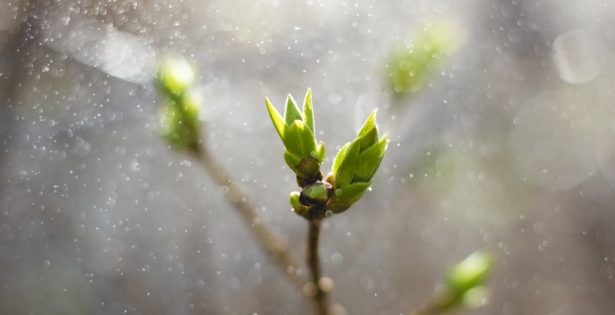As we approach spring, it’s a good time to discuss seasonal junctions. Both Ayurvedic and Chinese systems of medicine see the changes of seasons as times when we are more susceptible to being thrown out of balance as our body is challenged to adapt to the shift. Ayurveda has a saying that “diseases are generated at the junctions of the seasons.”
Other junctions are also challenging, with the challenge generally proportional to the magnitude of change. Ayurvedic teacher Robert Svoboda writes, “Ovulation and menstruation are the ‘joints’ of the menstrual cycle, dawn and dusk are the joints of day and night, and adolescence and menopause are the junctions of life.” If you have kids, you know that the “joints” of the day are the times you’re likely to have trouble, and if you’re clever, you find ways to make these transitions easy, such as the ever-popular “five more minutes until we’re leaving.”
Depending on where you live and your personal constitution, different seasons and junctions will be challenging for different people. For example, because spring tends to be wet, moving into this season means taking on more of what Traditional Chinese Medicine (TCM) calls dampness, or in Ayurveda an increase in kapha (“kaap-ha”). This will be most difficult for those who already have constitutional kapha or an accumulation of dampness in their system. Some of the signs and symptoms include: being overweight, having loose, sticky, or incomplete stools, a wide or coated tongue, feeling heavy and tired, finding it hard to wake up in the morning, and a tendency to be phlegmy.
Ayurveda might prescribe some therapeutic vomiting for such a condition, but these days, especially in the West, we prefer more pleasant medicine, ideally in gummy form, and we engage in therapeutic vomiting only after an excess of margaritas. Luckily, there are gentler ways to restore balance, and when it comes to management of the seasonal junctions, the most natural is to be aware of vulnerability during seasonal transitions and treat yourself with extra care. For someone with a delicate constitution or pre-existing health problems, this may be prudent at every season change. For others, only certain season changes may be troublesome. In any case, it’s a good idea to get extra sleep and to eat with greater care during the transition month.
If you have a personal challenge with the transition to spring, here are some more specific recommendations for this time.
- Eat more warm, cooked foods. Soups and stews are great. An ideal one is kitchari, made from rice and mung beans (there are lots of recipes online). If you have some of the kapha / damp challenges described above, you can add plenty of warming spices, including ginger, turmeric, cumin, coriander, turmeric, cinnamon, fenugreek, caraway, nutmeg, and black pepper. As the world gets warmer, start incorporating more fresh local produce.
- Avoid heavy, cold, and sweetened foods. These all tend to be cloying. Also, stop eating before you’re full, and let yourself get hungry between meals (don’t snack).
- Do some movement every day. Kapha / dampness tends to congeal in us when we’re immobile, sometimes making us feel achy, heavy, phlegmy, or groggy in the morning, after we’ve been horizontal for several hours. Daily movement, ideally with enough vigor to break a sweat, will help.
- Try a dry sauna. If you have access to a dry sauna, it can help counteract the effects of a damp environment. It doesn’t need to be too hot. You shouldn’t be pouring sweat. More sustainable is to have longer sessions in which your skin is just glistening.
- If you tend to get spring allergies, this is the time to prepare by babying your digestive system (eat slowly, deliberately, and only easily-digested foods) and taking some things to stabilize your immune system. Some of my favorites are quercetin (500mg twice a day), nettles (pick and steam your own if you can), local bee pollen, and homeopathic preparations of the things you’re allergic to. As for this last item, it’s akin to the old-school method of desensitization. There are companies that make super-dilute tinctures common allergens, such as tree pollen, grass pollen, animal hair, mold, dust, etc. I’ve had good experiences with ones made by a company called BioAllers.
For everyone – including those who have no particular challenge with the transition to spring – it’s worthwhile to pay attention to what’s happening in nature. Be fascinated by the return of new life. Notice the boisterous energy in the flowers and birds. Admire the vigor in the shoots that push their way through the crusted soil. The rising energy and lengthening days make it the ideal time for: planning, visualizing, cleansing, and shedding.
Wishing you a harmonious junction and beyond,
Peter



 Cart
Cart

Loved this one. Thank you for always putting such thoughtful messages out for others to benefit from.
Love this. I’m definitely going to check out the tree pollens at BioAllers
Very educational. Every year I go through allergy issues and have asthma. So it’s not a pleasant time for me. I will definitely incorporate some of these tips. Thank you!
Excellent and thought provoking, as always! Thank you Peter, I always find your writings interesting, thought-provoking and wise and helpful.
My husband as I read this reminds me that we are part of nature & the weather – right now a wall of wetness- has engulfed the farm. Noticing some of the changes you mentioned and will heed some of you’re advice (moving & warm foods) plus being aware & thoughtful to the changing of the season junction.
THANK You-!